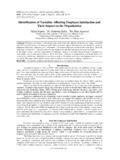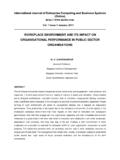Transcription of Appendix: Decompositions of Aggregate Labour Productivity ...
1 appendix : Decompositions of Aggregate Labour Productivity Growth A first step in the identification of the principal causes behind Canada s dismal Productivity performance since 2000 is to decompose Productivity growth into its main accounting components. Such an exercise provides important insights to guide a more behavioural analysis of factors affecting Labour Productivity . In this appendix we undertake three major Decompositions . First, we decompose Labour Productivity growth into its main sources for both Canada and the United States using the standard neoclassical growth accounting framework.
2 We then proceed to a provincial decomposition of Canada s Labour Productivity growth followed by an industry-based decomposition . A set of tables detailing the industry and provincial Decompositions can be found at the end of the appendix . Neoclassical Growth Accounting Using the neoclassical growth accounting framework and official estimates from Statistics Canada and the Bureau of Labor Statistics (BLS), we examine the sources of Productivity growth over the 1961-2006 The first section focuses on the sources of Productivity growth in Canada and the United States in recent years, focusing on the 1996-2000 and 2000-2006 sub-periods.
3 It is followed by a detailed analysis of historical trends in Canada and the United States since 1961 over six sub-periods, with an emphasis on the contrast between trends since 2000 and long term trends established in the 1973-2000 period. Growth Accounting in Canada and the United States since 1996 Applying a growth accounting decomposition to both the 1996-2000 and 2000-2006 sub-periods reveals once again that while Labour Productivity in the two countries followed similar patterns in the 1996-2000 period, their post-2000 performance diverged significantly.
4 In the 1996-2000 period, both Canada and the United States enjoyed strong Productivity growth. In both countries, about half of Productivity growth was explained by changes in measured Productivity inputs, that is either by an improved Labour composition2 or an increase in the intensity of capital services (which includes both changes in capital stock and capital composition) (Table A). 1 Baldwin and Gu (2007) have also done a growth accounting decomposition using these data focused on the 1996-2006 period rather than particularly on developments since 2000.
5 Our analysis extends only to 2006 as Statistics Canada KLEMS data for 2007 are not yet available. 2 Labour composition is the ratio of Labour input to hours worked. As such, Labour composition reflects the shifts in the educational attainment and work experience of the workforce. Labour input is calculated by aggregating the Labour input of three broad categories of educational attainment (primary or secondary education, some or completed postsecondary certificate or diploma and university degree or above). The Labour input of each educational category is a chained-Fisher aggregation of hours worked of those workers classified by work experience and class of workers (paid workers versus self-employed and unpaid family workers), using hourly compensation as weights.
6 Note that hours worked are used to calculate Labour Productivity growth, not the adjusted Labour input which includes changes in Labour composition. 2 Between 2000 and 2006, however, Canada s Labour Productivity growth has been well below that of the United States ( per cent versus per cent). In Canada, Labour composition contributed percentage point, capital intensity contributed percentage point and MFP contributed percentage point. The contribution of each factor was larger in the United States, with Labour composition contributing percentage point, capital intensity percentage point and MFP percentage point.
7 Interestingly, the contribution of Labour composition and capital services in absolute terms was almost identical in the United States and in Canada over the 2000-2006 period ( point versus point). Indeed, the key difference lies in the contribution of multifactor Productivity (MFP), which is percentage point larger in the United States than in Canada, accounting for almost all of the percentage point Labour Productivity growth difference over the 2000-2006 period. Table A: Sources of Growth in the Business Sector in Canada and the United States 1996-2000 and 2000-2006 Canada United States Canada minus United States 1996-2000 2000-2006 1996-2000 2000-2006 1996-2000 2000-2006 Average Annual Rate of Growth Output Total Hours Labour Composition Capital Services Capital Services Intensity Average Annual Percentage Point Contributions to Labour Productivity Growth Labour Productivity Labour Composition Capital
8 Intensity Multifactor Productivity Source: Calculations from the Canadian Productivity Accounts from Statistics Canada, Cansim Table 383-0021 for Canada. Bureau of Labor Statistics (BLS) Multifactor Productivity Program for the United States. Note that the BLS data is not entirely consistent with previous estimates as the most recent revisions to output have not yet been integrated in the BLS MFP program. Comparing periods, it is also mostly the change in MFP growth between 1996-2000 and 2000-2006, with percentage point per year acceleration in the United States and a percentage point deceleration in Canada, that accounts for how Canada went from a percentage point Labour Productivity advantage in 1996-2000 to a percentage point lag in the 2000-2006 period.
9 Yet again, explaining the cross-country MFP growth differential appears to be the key to solving Canada s recent Productivity 3 An interesting element to note, but which can explain only part of the cross-country difference in MFP growth, is the large implicit difference in capital share between Canada and the United States. In both sub-periods, capital services intensity in the United States has grown about 50 per cent faster than in Canada, yet is has only contributed slightly more to Labour Productivity than it has in Canada.
10 These estimates 3 This growth accounting exercise, even though it identifies MFP as the main culprit for the dismal Productivity growth in Canada since 2000 and for the Canada-US Labour Productivity growth gap, fails to identify the underlying reasons behind the diverging MFP growth rates. Even though MFP is often associated to technological progress, it is in fact a measure of our ignorance as it includes all effects which are not captured by either an improved Labour force or an increase in capital services. As such, identifying MFP growth as the main driver of Productivity differences is not particularly insightful.











